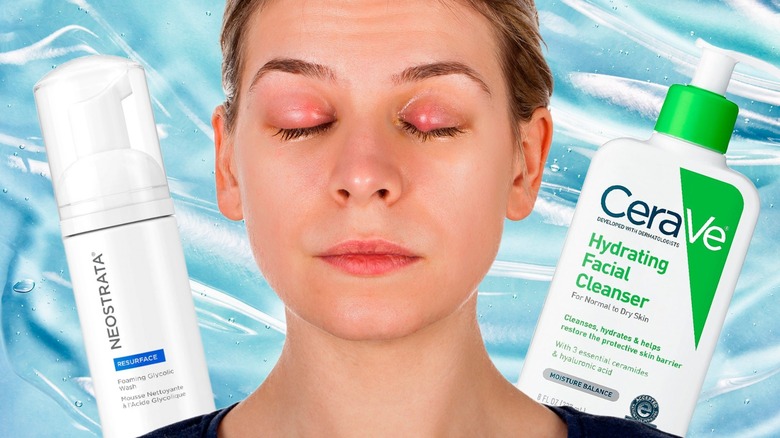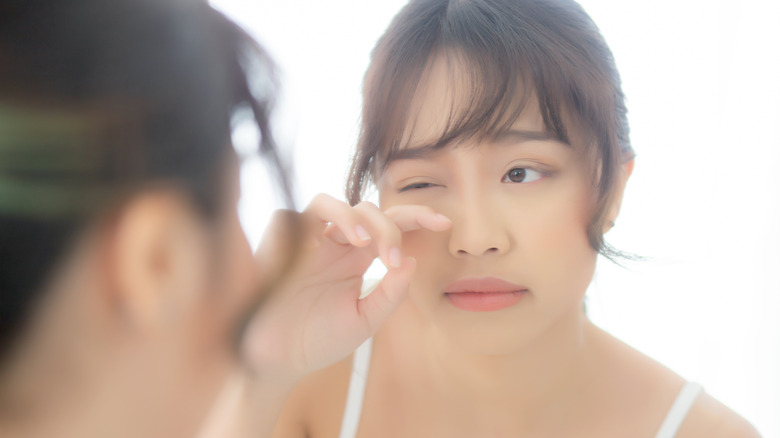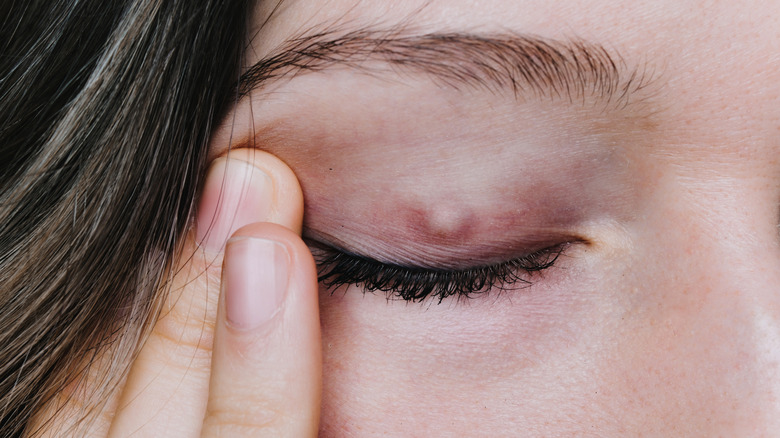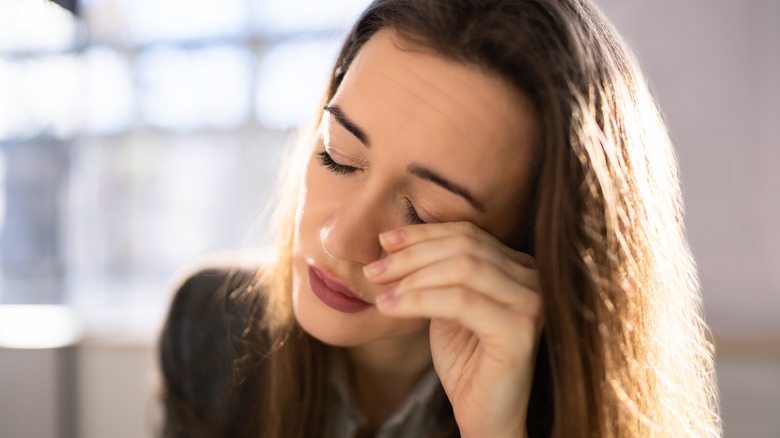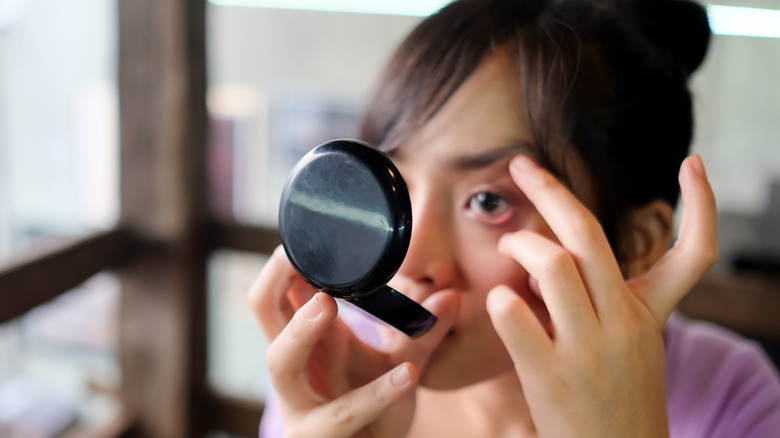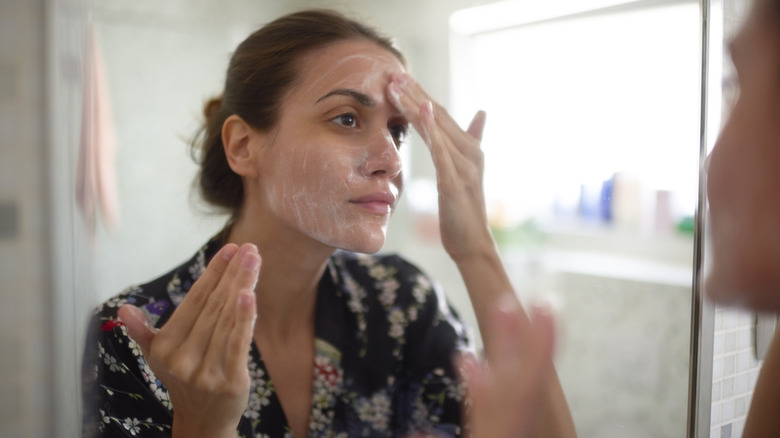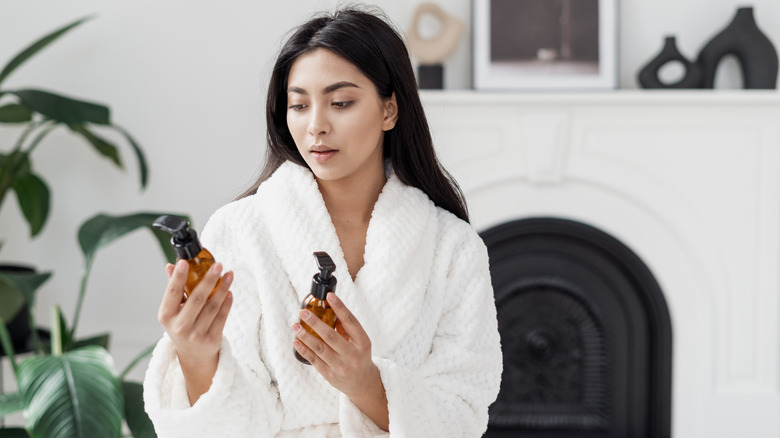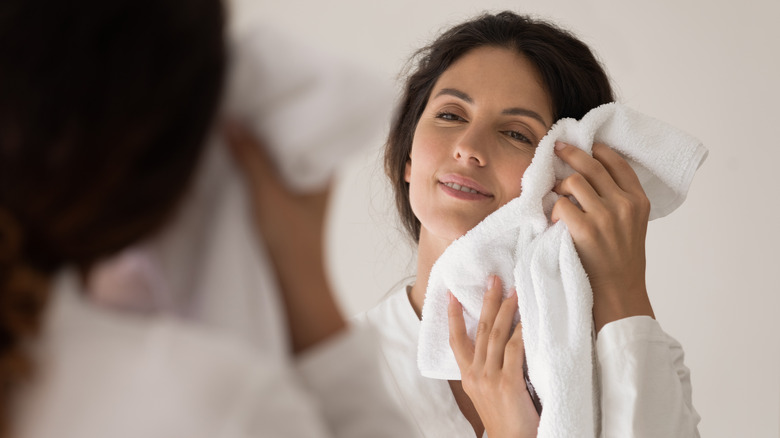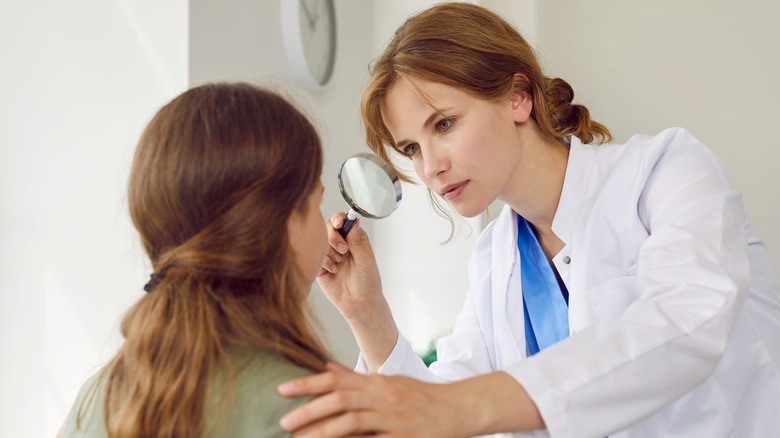Eyelid Breakouts: How To Treat & Prevent Them
When you think of a pesky breakout, you might imagine a bump on your chin or a zit on your forehead. But sometimes, spots can crop up on our eyelids, a location that might make acne less obvious compared to the middle of your face (yay!) but can also cause irritation and even vision problems for your eyes, according to Healthline (bummer).
To make matters more complicated, eyelid breakouts require different treatment than your standard pimple. That means the spot treatments and pimple patches you rely on for the rest of your face likely won't do any good when you get a bump above your eye. The good news, however, is that you can easily prevent these annoying spots with careful hygiene practices and the right products. And if you're already dealing with an unwanted eyelid lump, don't panic — most eyelid breakouts will go away on their own without doctor intervention, notes Mount Sinai. If you're feeling impatient, a few simple home remedies can help speed up the healing process.
What are eyelid breakouts?
First, there's one point we need to get out of the way: Your eyelid pimples probably aren't the same type of pimples you get elsewhere on your body. "While pimples can happen around your eyes, if you're dealing with what looks like a pimple directly on the eyelid, it's probably a stye," board-certified dermatologist Dr. Hadley King revealed to Skincare.com. As Dr. King noted, acne forms when sebaceous glands, found in hair follicles, become clogged. However, the glands on the eyelids vary from other areas of the body. "Styes form when specialized eyelid glands, called meibomian glands, become clogged," the dermatologist explained.
If your lesions are smaller than a typical pimple, they might be milia rather than styes. "Milia are 1-2 mm pinhead-sized, superficial skin cysts filled with keratin debris that often occur on the skin around the eyes and on the eyelid skin itself," Dr. Nadia Kihiczak of Spring Street Dermatology explained to Byrdie. According to the American Academy of Ophthalmology, these bumps often look similar to acne whiteheads, but they don't cause any pain or discomfort.
What causes eyelid breakouts?
Whether your eyelid bump is a stye, milium, or another type of spot, there are a few common culprits. First, similar to other types of breakouts, skin oils might be a factor in your eyelid pimples. "Sometimes oils are running thicker and don't flow out like they're supposed to, and this oil can't get out one or more of the openings," Dr. Preeti J. Thyparampil, an ophthalmologist and oculoplastic surgeon, told Women's Health. "The painful bump that develops is an accumulation of this oil."
Heavy or irritating products may exacerbate these blockages in the skin. "Anything that causes itchiness, irritation, or inflammation in the eye area (periorbital region) can increase the likelihood of breakouts on the eyelid," Dr. Nadia Kihicza told Byrdie. "Additionally, application of creams and lotions that are not typically indicated for facial or periorbital skin can also lead to irritation of the eyelids, which can lead to rubbing of the eyes and subsequently results in clogging of the pores and glands in the eyelid skin."
Finally, poor hygiene could be to blame for some eyelid spots. In the case of a stye, a bacterial infection causes a swollen, red lump to form, per the Mayo Clinic. Touching the eye area with unwashed hands or applying old, expired products can increase your risk of developing a stye.
How long do eyelid breakouts last?
Eyelid bumps can come and go, but their lifespan often depends on the type of breakout and how well it's treated. According to Healthline, styes generally only stick around for a few days, though they can last for over a week. If the bacteria from the stye spreads to other areas around the eye, such as from touching or rubbing the eyelid, you could develop a secondary infection. Moreover, touching or squeezing the spot may increase swelling, potentially delaying the healing process. In some cases, you may also find that a stye turns into a harder eyelid bump. This spot is likely a chalazion, per WebMD, and will require additional time to heal.
Milia tend to last longer on the eyelids than styes. Expect these tiny, white spots to linger for a few weeks to a couple of months, says Cleveland Clinic. With either type of breakout, it's important to follow some basic care steps to avoid further irritation.
Don't pop or squeeze
When it comes to pimples, you know the drill: Don't pop, pick, or squeeze them. Even if the bumps on your eyelids aren't your standard zits, the same rule applies. The American Academy of Ophthalmology notes that messing with a stye might worsen the infection. In serious cases, the bumps can be drained, though only by a doctor, with the help of a local anesthetic. Milia, too, should never be squeezed. Not only is trying to pop milia ineffective, but it can also damage the delicate skin on your eyelids.
Keep the eye area clean
If you already have a bump on your eyelid, it's a good idea to keep the area clean to avoid spreading infection-causing bacteria. But even if you don't have a pesky spot, good hygiene can help prevent one from popping up. "Prevention includes washing hands before applying contacts or makeup, and avoiding these during a breakout, minimizing eyelid rubbing, cleaning contacts as instructed, not sharing eye makeup, and keeping makeup brushes clean," Dr. Roy Seidenberg, a board-certified dermatologist at New York's Laser & Skin Surgery Center, shared with Byrdie.
It's also crucial to cleanse your eyelids just as you do the rest of your face. Start by removing makeup with a wipe or cotton pad, but don't stop there. "Cleansing wipes remove a bulk of bacteria, dirt, and oil, but also leave a trail of residue behind," Dr. Rachel Nazarian, a New York City-based dermatologist, explained to Insider. "This can potentially lead to acne and infected glands, especially around the eyelids and eyelashes. Appropriate facial cleansing requires a water-based rinse to fully clean." Use a gentle soap to help lift any stubborn oil or caked-on eyeshadow. If your go-to cleanser is too rough for your eyes, some doctors recommend using a tiny bit of baby shampoo mixed with water, as per the American Academy of Ophthalmology.
Avoid harsh or heavy products
Treating breakouts with harsh, acne-fighting products might seem like the way to go, but eyelid bumps generally require gentler remedies — both for speeding up recovery and for preventing future spots. As Medical News Today points out, harsh ingredients can exacerbate oily eyelids rather than keeping gland-clogging oil under control. Similarly, dermatologist Dr. Joshua Zeichner told Bustle that ingredients commonly used to treat pimples, such as salicylic acid and benzoyl peroxide, should never be used around the eyes, as they may cause irritation, especially for people with sensitive skin.
When in doubt, stick to "non-comedogenic, gentle cleansing products and face-specific creams, Dr. Nadia Kihiczak suggested to Byrdie. The term "non-comedogenic" refers to products that don't contribute to clogged pores, and you'll find it listed on some skincare labels. When using eye creams, also be sure to not go overboard. A pea-sized amount is just enough to get the skin benefits without the heaviness.
Treat eyelid bumps with a warm compress
If you've kept your eyelids clean and avoided problematic ingredients, but you're still stuck with an eyelid breakout that won't budge, try applying a little heat. A warm compress can speed up the healing process of a bump, especially if it's a stye or chalazion. For a quick and easy solution, grab a clean washcloth and a bowl of warm water. Dr. Sunir Garg, clinical spokesperson for the American Academy of Ophthalmology and a professor of ophthalmology at Wills Eye Hospital, told Women's Health that the compress should be kept hot, so try microwaving or barely simmering the water and then dip the cloth in the water as needed to retain heat for 10 minutes. Repeat this method twice a day for several days until the bump shrinks.
Alternatively, pop on a heatable eye mask several times throughout the day, as Dr. Lora Glass, assistant professor of ophthalmology and director of Medical Student Education in ophthalmology at Columbia University Medical Center, suggested to Self. When reusing a mask, be sure to disinfect it first or cover it with a clean cloth.
Visit your doctor
If your eyelid breakouts don't go away — or keep coming back — consider it your skin's way of telling you it's time to visit your doctor. If an infection is causing your chronic bumps, a dermatologist may prescribe an antibiotic ointment that's safe to use in the eye area, as per Healthline. For milia, a doctor may suggest cryotherapy, laser surgery, chemical peels, or other medical treatments, according to the American Academy of Ophthalmology.
In some cases, a bump on your eyelid could be a sign of a serious illness, including cancer. Stanford Medicine explains that because the eyelids are particularly sensitive to the sun, the area is a common spot for skin cancer to develop (some statistics suggest that 5% to 10% of all skin cancers are found on the eyelids, as per Cancer.Net). Signs of cancer include new growth on the eyelids, skin swelling or thickening, loss of eyelashes, and other changes in appearance. Be sure to discuss any concerns or symptoms with your doctor to get a proper diagnosis.
